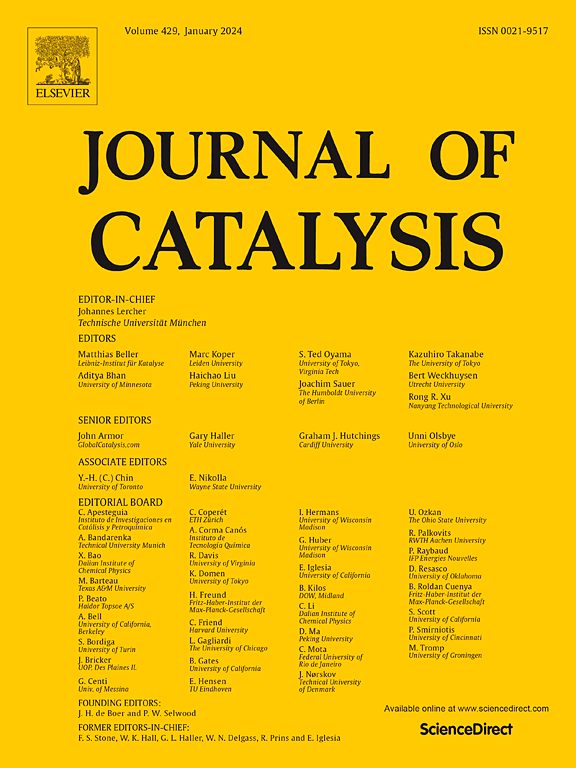Abridging the modeling of CO oxidation on single-atom catalysts: From microkinetics to descriptor-based analysis
IF 6.5
1区 化学
Q2 CHEMISTRY, PHYSICAL
引用次数: 0
Abstract
Single-atom catalysts (SACs) display prominent performance and high metal utilization for numerous catalytic processes. Harnessing the interaction between single atoms and supports is crucial to improve the performance of SACs. By means of density functional theory calculations and microkinetic modeling including adsorbate interactions, we expose the promising synergy between 3d–5d single metal atoms (M) and TiO2(110) for CO oxidation. Upon a rigorous analysis, we identify the adsorption energy of O at M sites as a simple and robust descriptor to abridge the design of catalysts for CO oxidation on M/TiO2 catalysts, so that enhanced activities are predicted at mild O adsorption energies. Single Pt and Rh atoms provide the largest enhancement around 400 K, with CO2 formation rates 7–8 orders of magnitude higher than on TiO2(110). Non-precious Ta/TiO2 and Mn/TiO2 also exhibit salient activities. This work highlights the often disregarded yet central role of adsorbate interactions in CO oxidation.


简化单原子催化剂上CO氧化的建模:从微动力学到基于描述符的分析
单原子催化剂在多种催化过程中表现出优异的性能和较高的金属利用率。利用单原子和支架之间的相互作用是提高sac性能的关键。通过密度泛函理论计算和包括吸附质的相互作用在内的微动力学建模,我们揭示了3d-5d单金属原子(M)和TiO2(110)之间在CO氧化中的有希望的协同作用。经过严格的分析,我们确定O在M位点的吸附能是一个简单而可靠的描述符,可以简化M/TiO2催化剂上CO氧化催化剂的设计,因此预测在温和的O吸附能下活性增强。单个Pt和Rh原子在400 K左右提供了最大的增强,其CO2形成速率比TiO2(110)高7-8个数量级。非贵金属Ta/TiO2和Mn/TiO2也表现出显著的活性。这项工作强调了吸附质相互作用在CO氧化中经常被忽视的核心作用。
本文章由计算机程序翻译,如有差异,请以英文原文为准。
求助全文
约1分钟内获得全文
求助全文
来源期刊

Journal of Catalysis
工程技术-工程:化工
CiteScore
12.30
自引率
5.50%
发文量
447
审稿时长
31 days
期刊介绍:
The Journal of Catalysis publishes scholarly articles on both heterogeneous and homogeneous catalysis, covering a wide range of chemical transformations. These include various types of catalysis, such as those mediated by photons, plasmons, and electrons. The focus of the studies is to understand the relationship between catalytic function and the underlying chemical properties of surfaces and metal complexes.
The articles in the journal offer innovative concepts and explore the synthesis and kinetics of inorganic solids and homogeneous complexes. Furthermore, they discuss spectroscopic techniques for characterizing catalysts, investigate the interaction of probes and reacting species with catalysts, and employ theoretical methods.
The research presented in the journal should have direct relevance to the field of catalytic processes, addressing either fundamental aspects or applications of catalysis.
 求助内容:
求助内容: 应助结果提醒方式:
应助结果提醒方式:


